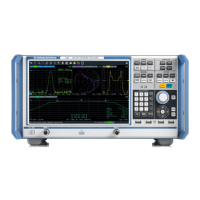Concepts and Features
R&S
®
ZNB/ZNBT
131User Manual 1173.9163.02 ─ 53
If <mout> is different from <min>, the S-parameters are called mode conversion fac-
tors.
Mixed Mode Parameters for Different Test Setups
Which types of mixed mode parameter are available depends on the measured device
and the port configuration of the analyzer. With 4 physical test ports (on the VNA and
connected External Switch Matrices), the following examples of mixed mode parame-
ters can be measured.
1. DUT with only single-ended ports: No balanced port definition necessary, the ana-
lyzer provides single-ended multiport parameters.
2. DUT with one balanced port: Only reflection and mode conversion measurements
with differential and common mode parameters.
3. DUT with one balanced and one single-ended port.
4. DUT with two balanced ports or one balanced and two single-ended ports. Both
device types are fully characterized by 4x4 mixed mode S-matrices.
5.3.6.3 Imbalance and Common Mode Rejection
An ideal unbalance-balance transformer (balun) converts an unbalanced signal into a
balanced one and vice versa. When it is driven with an unbalanced signal at its physi-
cal port 1 (= single-ended logical port 1), unbalanced signals with equal amplitude and
opposite phase appear at physical ports 2 and 4 (forming balanced logical port 2). This
means that the ratio –S
21
/S
41
of the physical transmission coefficients of an ideal balun
equals 1. This ratio is called imbalance; it is a measure for the deviation of the balun
from ideality. The general definition of the transmission imbalance between two differ-
ent ports (at least one of them balanced) is given below.
For a DUT with two balanced ports (e.g. an amplifier), the ratio between the (wanted)
differential mode power gain and the (unwanted) common mode power gain is called
Measurement Results

